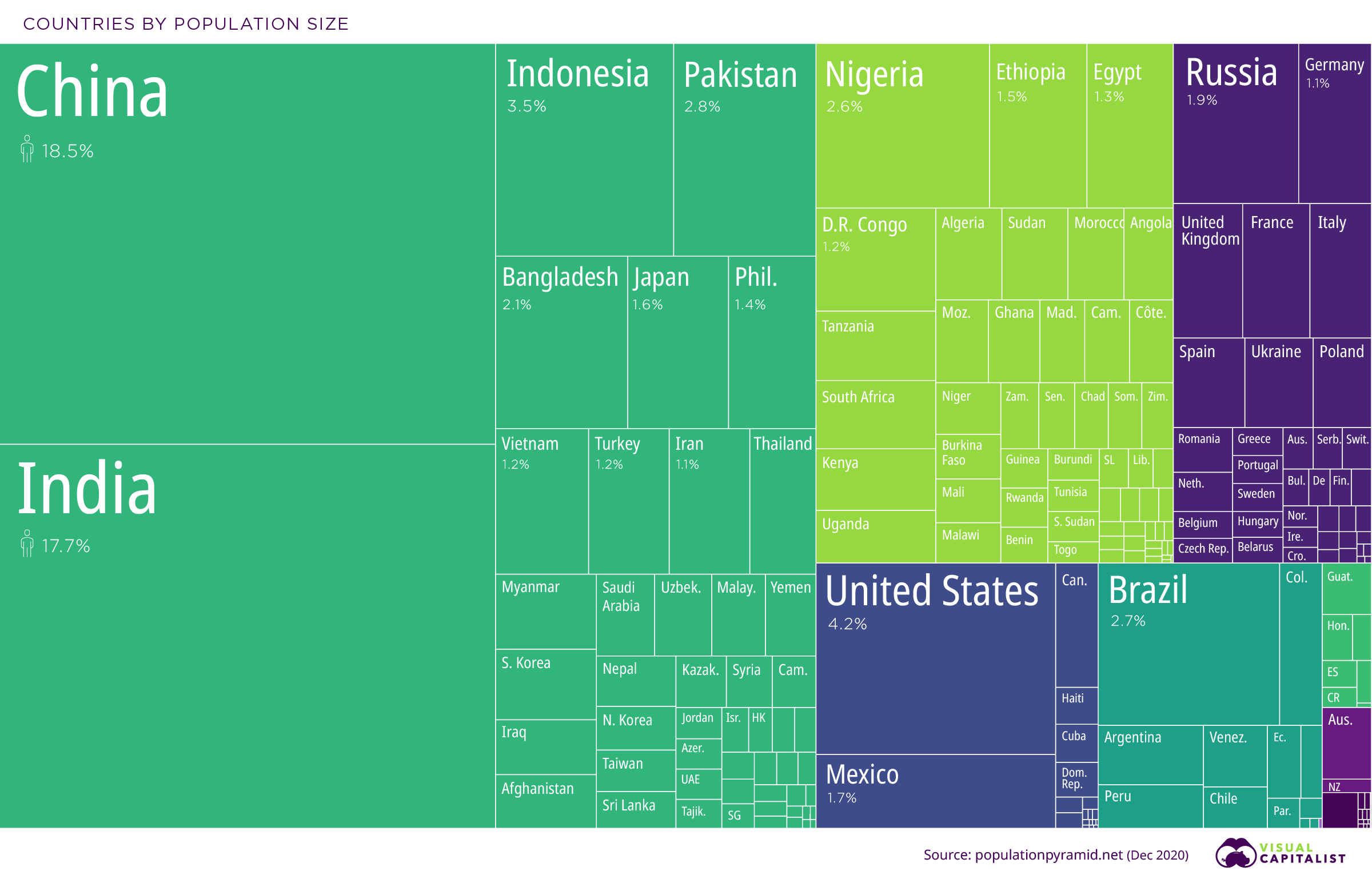Visualizing the Most Populous Countries in the World
 |
Visualizing the Most Populous Countries in the World
India’s population is projected to surpass China’s as soon as 2022.
While this is consequential on a global economic level, it also leaves other population trends overlooked. For instance, Nigeria is projected to have more people than the U.S., the world’s third-largest country by population, by the year 2050.
This treemap visualization, adapted from PopulationPyramid.net, is an overview of the global population in 2020, showing us the world’s most populous countries.
The 50 Most Populous Countries
China, with a population of 1.44 billion, is the most populous country worldwide.
In 2019, over 60% of its population resided in urban centers, a trend that has seen the portion of city dwellers double over the last 25 years. For context, 83% of the U.S. population lives in cities, while just 35% of India’s population dwells in urban areas.
Together, China and India’s populations make up over 36% of the global total.
Extending over 17,000 islands, Indonesia comes fourth among the world’s most populous countries, standing at 273.5 million people.
Pakistan comes in fifth, with 220.8 million. Karachi, located on the southeastern coast of Pakistan, is home to over 16 million people alone. It is Pakistan’s most populous city, and the seventh-largest city in the world.
Nigeria also makes it onto the list. In just three decades, the country’s population is projected to climb from 206 million to 400 million—growing at a percentage clip that is more than double that of India.
The 50 Least Populous Countries
Combined, the 50 least-populous countries make up 0.4% of the total world population. By contrast, the top 50 account for 87% of the total.
Unsurprisingly, the world’s low population nations are situated on small islands, often tropical and reliant on tourism.
The Caribbean island nation of Antigua and Barbuda has the smallest population in the world, with just 97,928 inhabitants. While it may be small in terms of total inhabitants, its population density is another story—with over 222 people per square kilometer. That is roughly 50% higher than China, but about half the population density of India.
Meanwhile, the 33 pacific islands of Kiribati also make the top 10 list of the least populous countries worldwide. With a population of 119,400, Kiribati was a testing site for atomic bombs by the British and Americans during the 1960s. The island reached independence in 1979, after being under crown colonial rule since 1916.
Regional Median Ages
How about the median ages across these populations?
By far, the African region has the lowest median age at 19.8 years old, partially driven by a high birth rate of 4.7 children per woman. In contrast, the global average falls around 2.5 children.
By 2050, Africa’s population will effectively double from 1.3 billion to 2.5 billion.
| Region | Annual Rate of Natural Population Increase | Median Age (2020) |
|---|---|---|
| Africa | 2.5% | 19.8 years |
| Asia | 0.9% | 32.1 years |
| Central America | 1.2% | 28.3 years |
| Europe | -0.1% | 42.7 years |
| Latin America & Caribbean | 0.9% | 30.9 years |
| Northern America | 0.3% | 38.6 years |
| Oceania | 0.9% | 33.5 years |
| South America | 0.9% | 32.0 years |
| World | 1.0% | 30.9 years |
Source: Our World in Data
On the other hand, Europe is the oldest, at 42.7 years for this demographic metric.
With a median age of 47.9, Italy has the second-oldest population in the world, topped only by Japan. Meanwhile, Germany (46.6), Portugal (46.2), and Spain (45.5) fall next in line. If current trends continue, by 2050, half of Europe’s population will be non-working and over the age of 65.
That said, it should be noted that this trend is not exclusive to Europe. In 30 years, 1.5 billion people globally will be over the age of 65, amounting to 16% of the global population.


 China
China India
India U.S.
U.S. Indonesia
Indonesia Pakistan
Pakistan Brazil
Brazil Nigeria
Nigeria Bangladesh
Bangladesh Russian Federation
Russian Federation Mexico
Mexico Antigua and Barbuda
Antigua and Barbuda Seychelles
Seychelles United States Virgin Islands
United States Virgin Islands Tonga
Tonga Aruba
Aruba Saint Vincent and the Grenadines
Saint Vincent and the Grenadines Grenada
Grenada Micronesia (Fed. States of)
Micronesia (Fed. States of) Kiribati
Kiribati Curaçao
Curaçao